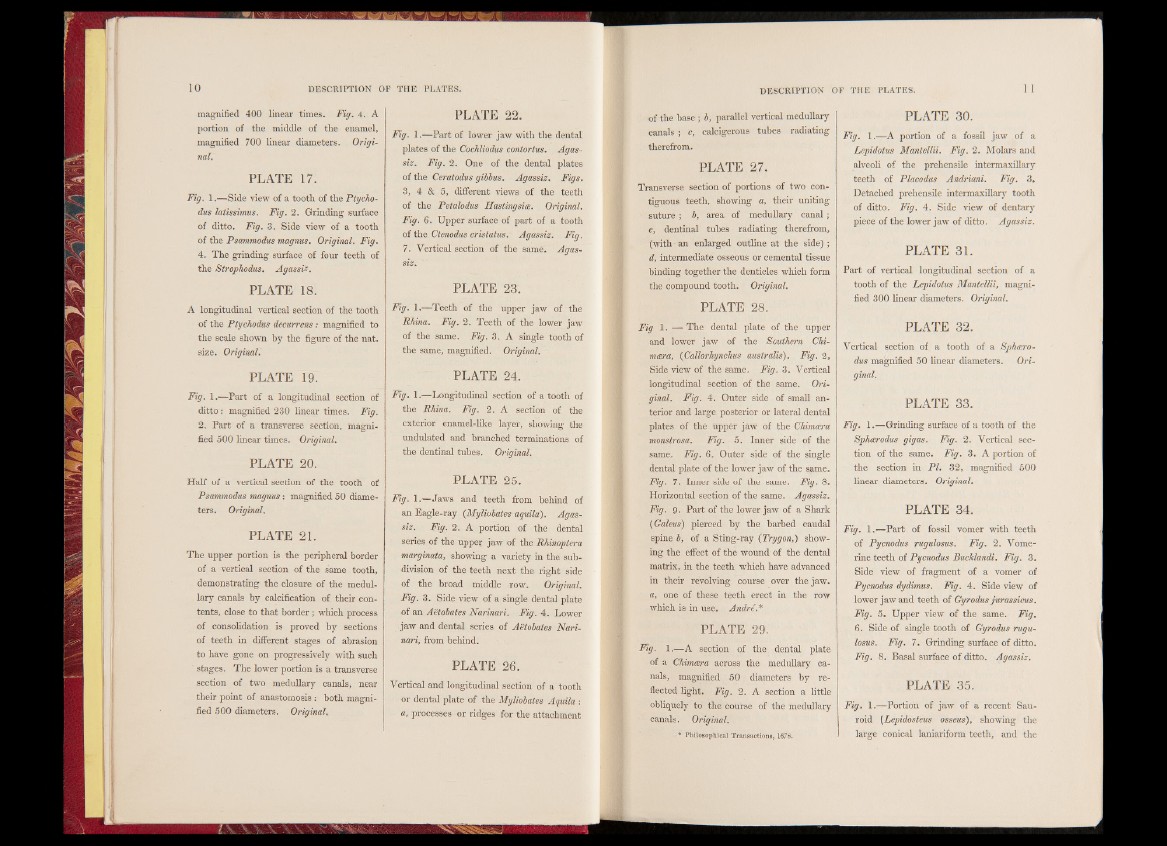
magnified 400 linear times. Fig. 4. A
portion of the middle of the enamel,
magnified 700 linear diameters. Original.
PLATE 17.
Fig. T.—Side view of a tooth of the Ptycho-
dus latissimus. Fig. 2. Grinding surface
of ditto. Fig. 3, Side view of a tooth
of the Psammodus magnus. Original. Fig.
4. The grinding surface of four teeth of
the Strophodus. Agassiz.
PLATE 18.
A longitudinal vertical section of the tooth
of the Ptychodus decurrens: magnified to
the scale shown by the figure of the nat.
size. Original.
PLATE 19.
Fig. 1.—Part of a longitudinal section of
ditto: magnified 230 linear times. Fig.
2. Part of a transverse section, magnified
500 linear times. Original.
PLATE 20.
Half of a vertical section of the tooth of
Psammodus magnus: magnified 50 diameters.
Original.
PLATE 21.
The upper portion is the peripheral border
of a vertical section of the same tooth,
demonstrating the closure of the medullary
canals by calcification of their contents,
close to that border; which process
of consolidation is proved by sections
of teeth in different stages of abrasion
to have gone on progressively with such
stages. The lower portion is a transverse
section of two medullary canals, near
their point of anastomosis : both magnified
500 diameters. Original.
PLATE 22.
Fig. 1.—Part of lower jaw with the dental
plates of the Cochliodus contortus. Agassiz.
Fig. 2. One of the dental plates
of the Ceratodus gibbus. Agassiz. Figs.
3, 4 & 5, different views of the teeth
of the Petalodus Hastingsite. Original.
Fig. 6. Upper surface of part of a tooth
of the Ctenodus cristatus. Agassiz. Fig.
7. Vertical section of the same. Agassiz.
PLATE 23.
Fig. 1.—Teeth of the upper jaw of the
Rhina. Fig. 2. Teeth of the lower jaw
of the same. Fig. 3. A single tooth of
the same, magnified. Original.
PLATE 24.
Fig. 1.—Longitudinal section of a tooth of
the Rhina. Fig. 2. A section of the
exterior enamel-like layer, showing the
undulated and branched terminations of
the dentinal tubes. Original.
PLATE 25.
Fig. 1.—Jaws and teeth from behind of
an Eagle-ray (Mylidbates aquila). Agassiz.
Fig. 2. A portion of the dental
series of the upper jaw of the Rhinoptera
marginata, showing a variety in the subdivision
of the teeth next the right side
of the broad middle row. Original.
Fig. 3. Side view of a single dental plate
of an Aetobates Narinari. Fig. 4. Lower
jaw and dental series of Aetobates Narinari,
from behind.
PLATE 26.
Vertical and longitudinal section of a tooth
or dental plate of the Myliobates Aquila :
a, processes or ridges for the attachment
of the base ; b, parallel vertical medullary
canals ; c, calcigerous tubes radiating
therefrom.
PLATE 27.
Transverse section of portions of two contiguous
teeth, showing a, their uniting
suture ; b, area of medullary canal ;
c, dentinal tubes radiating therefrom,
(with an enlarged outline at the side) ;
d, intermediate osseous or cemental tissue
binding together the denticles which form
the compound tooth. Original.
PLATE 28.
Fig 1. — The dental plate of the upper
and lower jaw of the Southern Chi-
mæra, (Callorhynchus australis). Fig. 2,
Side view of the same. Fig. 3. Vertical
longitudinal section of the same. Original.
Fig. 4. Outer side of small anterior
and large posterior or lateral dental
plates of the upper jaw of the Chimoera
monstrosa. Fig. 5. Inner side of the
same. Fig. 6. Outer side of the single
dental plate of the lower jaw of the same.
Fig. 7. Inner side of the same. Fig. 8.
Horizontal section of the same. Agassiz.
Fig. 9. Part of the lower jaw of a Shark
(Galeus) pierced by the barbed caudal
spine b, of a Sting-ray (Trygon,) showing
the effect of the wound of the dental
matrix, in the teeth which have advanced
in their revolving course over the jaw.
a, one of these teeth erect in the row
which is in use. André.*
PLATE 29.
Fig. 1.—A section of the dental plate
of a Chimrera across the medullary canals,
magnified 50 diameters by reflected
light. Fig. 2. A section a little
obliquely to the course of the medullary
canals. Original.
* Philosophical Transactions, 1678.
PLATE 30.
Fig. 1.—A portion of a fossil jaw of a
Lepidotus Mantellii. Fig. 2. Molars and
alveoli of the prehensile intermaxillary
teeth of Placodus Andriani. Fig. 3.
Detached prehensile intermaxillary tooth
of ditto. Fig. 4. Side view of dentary
piece of the lower jaw of ditto. Agassiz.
PLATE 31.
Part of vertical longitudinal section of a
tooth of the Lepidotus Mantellii, magnified
300 linear diameters. Original.
PLATE 32.
Vertical section of a tooth of a Sphtero-
dus magnified 50 linear diameters. Original.
PLATE 33.
Fig. 1.—Grinding surface of a tooth of the
Spharodus gigas. Fig. 2. Vertical section
of the same. Fig. 3. A portion of
the section in PI. 32, magnified 500
linear diameters. Original.
PLATE 34.
Fig. 1.—Part of fossil vomer with teeth
of Pycnodus rugulosus. Fig. 2. Vomerine
teeth of Pycnodus Bucklandi. Fig. 3.
Side view of fragment of a vomer of
Pycnodus dydimus. Fig. 4. Side view of
lower jaw and teeth of Gyrodus jurassicus.
Fig. 5. Upper view of the same. Fig.
6. Side of single tooth of Gyrodus rugulosus.
Fig. 7. Grinding surface of ditto.
Fig. 8. Basal surface of ditto. Agassiz.
PLATE 35.
Fig. 1.—Portion of jaw of a recent Sau-
roid (Lepidosteus osseus), showing the
large conical laniariform teeth, and the